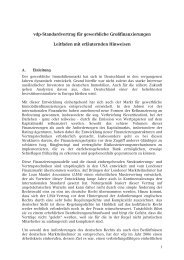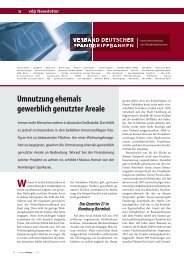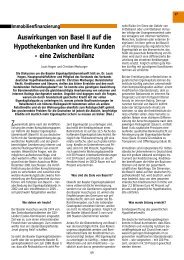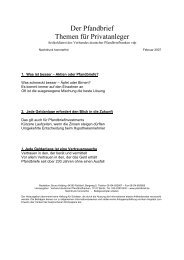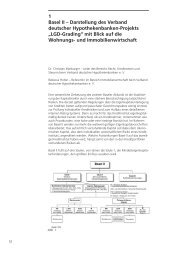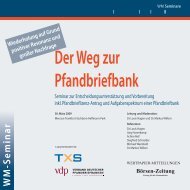The Pfandbrief 2011 | 2012
The Pfandbrief 2011 | 2012
The Pfandbrief 2011 | 2012
You also want an ePaper? Increase the reach of your titles
YUMPU automatically turns print PDFs into web optimized ePapers that Google loves.
<strong>Pfandbrief</strong>e in Securities Indices – Current Trends and Applications<br />
OVERVIEW OF COVERED-BOND ETFs<br />
Investment spectrum Name Bloomberg Currency AuM Replication<br />
Germany ISHARES EBREXX JUM PFANDB DE R1JKEX GT EUR 1178 Full*<br />
Germany COMSTAGE ETF IBOXX GERMANY C540 GT EUR 10 Swap**<br />
Germany DB X-TR II IBOXX GERM CV TR XBCT GT EUR 255 Swap<br />
Europe LYXOR ETF EUROMTS CBA ECB FP EUR 119 Swap<br />
Eurozone ISHARES MARKIT IBOXX EU CV B ICOV LN EUR 136 Full<br />
Eurozone ISHARES MARKIT IBOXX EU CV B SCOV LN GBP 121 Full<br />
* Full Replication means actual 1:1 investment in all index components<br />
** Swap-Based Replication is accomplished through the aid of a total-return swap at the fund level<br />
Sources: Bloomberg, UniCredit Research<br />
Particularly Interesting for Smaller Institutional and Large Private Investors<br />
54<br />
Although covered-bond ETFs play a subordinated role in comparison to total market volume,<br />
they nevertheless constitute an attractive investment option, particularly for small institutional<br />
investors and larger private investors. Currently, investors are split roughly into 80% institutional<br />
investors, including, in particular, non-financials, and 20% retail customers. <strong>The</strong>re are<br />
two reasons why smaller insurance companies to date have not invested more heavily in fixedincome<br />
ETFs generally and covered-bond ETF specifically: the fact that these segments in<br />
particular have been seen as forming part of their core expertise, meaning that the preference<br />
has been for direct investment or tightly structured special funds; in addition, the lot sizes that<br />
even smaller insurance companies trade are too extensive as to be able to be depicted in connection<br />
with ETFs.<br />
However, for investors with lot sizes of up to EUR 1 million per order, country-specific<br />
ETFs in particular represent an excellent basis for core-satellite strategies, i.e. the allocation<br />
of a total investment into a highly diversified core investment (“Core”) that should offer a basic<br />
yield with adequate security, and several individual investments (“Satellites”) that reflect the<br />
investor’s specific view of the market. For this reason, country-specific ETFs are particularly<br />
well suited, since they allow a certain pre-selection. This is necessary, because in spite of a<br />
number of efforts – above all, in 2006 – a functioning CDS market for covered bonds never<br />
emerged. Accordingly, even within a core-satellite approach, only a long-only strategy is possible.<br />
Even though it is possible to calculate a hedge ratio of covered bond to senior CDS that is<br />
fair under ratings models, the basic risk and the hedge would have to be continually adjusted.<br />
At the same time, however, using the specific example of the aforementioned covered-bond<br />
ETF, a practicable strategy can be described with a core of <strong>Pfandbrief</strong>e. Due to shrinking volume<br />
outstanding, a direct investment of small lot sizes in the <strong>Pfandbrief</strong> market is likely to be<br />
accompanied by less favourable pricing terms. For this reason, a core strategy using ETFs is<br />
highly advisable, particularly for smaller lot sizes. Investments in specific names within the<br />
<strong>Pfandbrief</strong> segment that go beyond the index weight, or investments in a European context,<br />
would then be characterised as a satellite investment.




